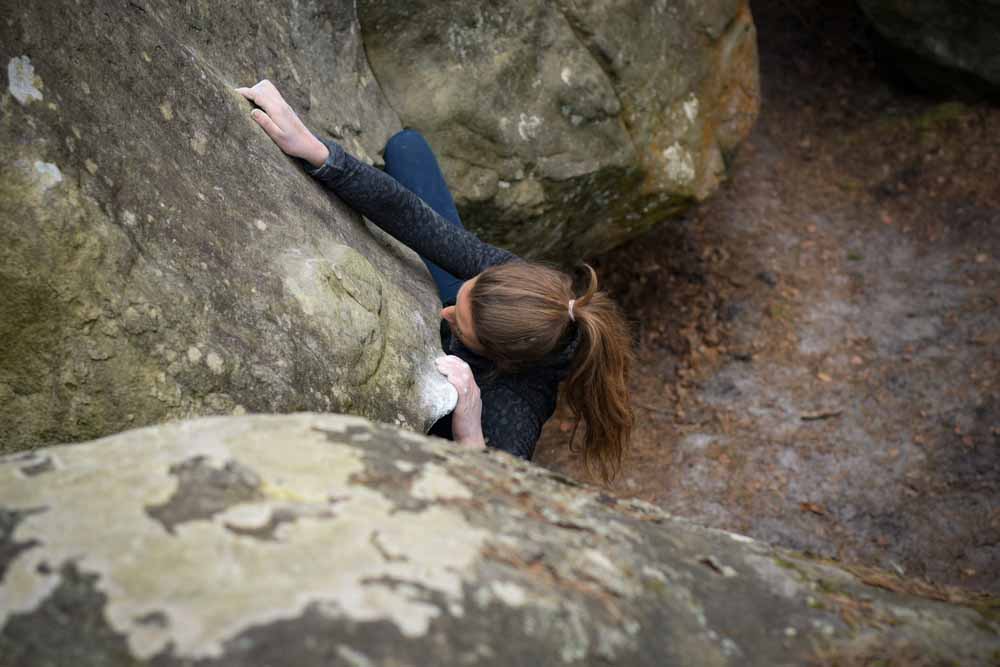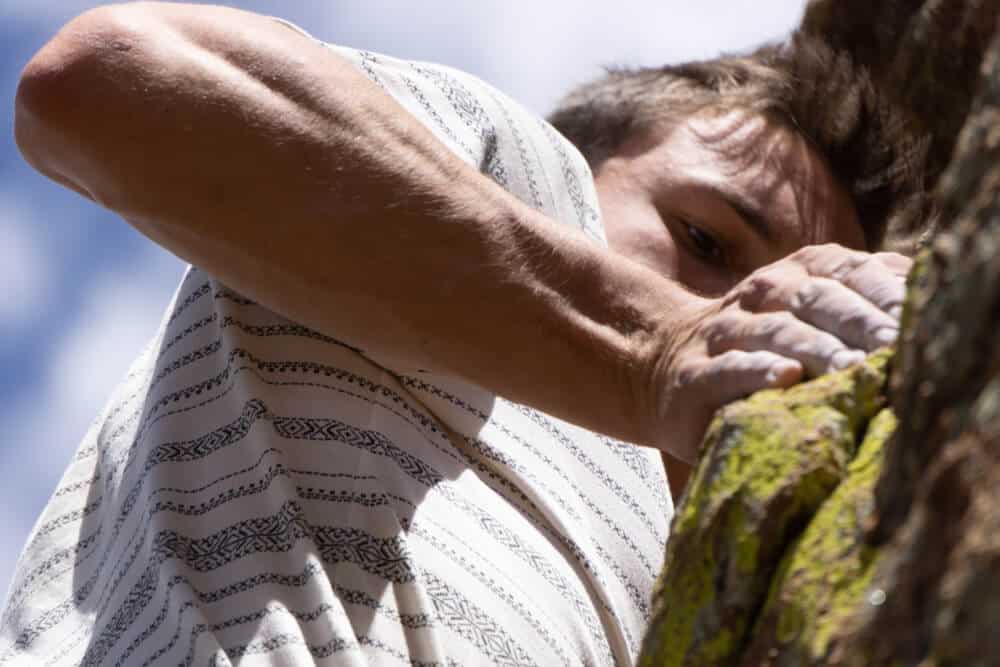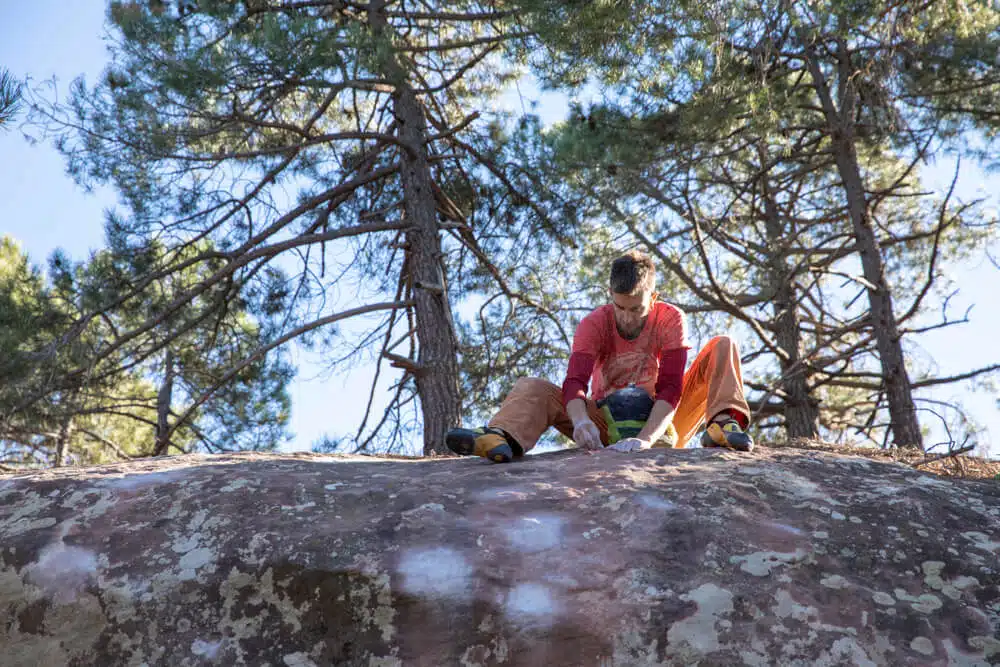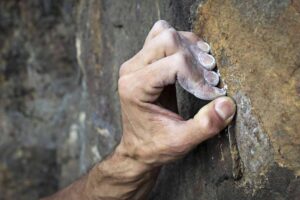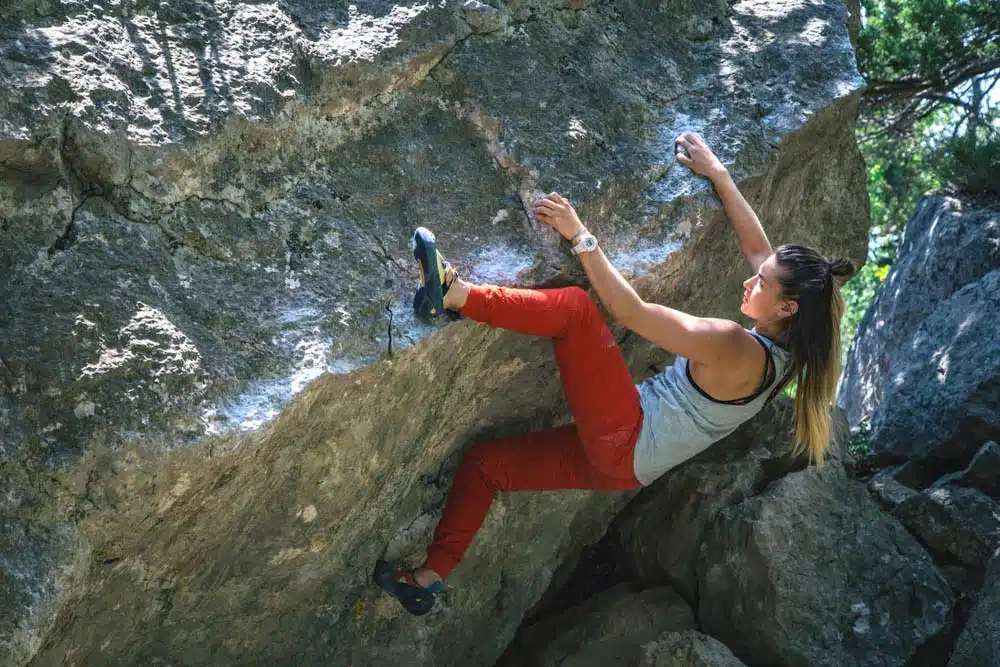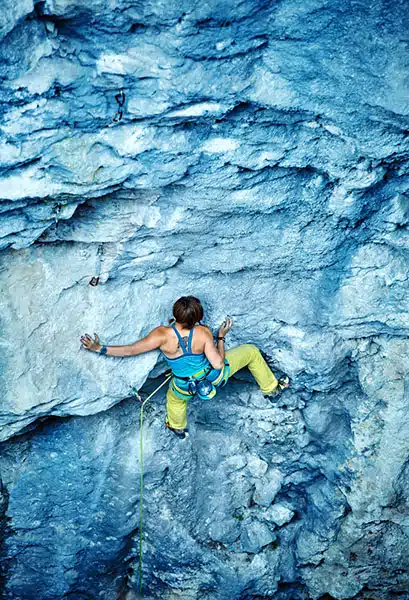If you need to top out a boulder problem or pull yourself onto a ledge while climbing, chances are you’ll use a mantle.
A mantle in climbing is when you transition from pulling to pushing in order to hoist yourself up onto a ledge or large hold.
If you’re unfamiliar with the concept of a mantle, think about getting out of a swimming pool: you place your hands on the ground and pull your body up until your body weight is above your hands. Then, you flip your hands and push with your palms until you can step on the ground. This is a mantle!
This article will review mantling technique, as it’s an essential thing to have in your climbing arsenal.
Curious about other climbing techniques? Check out some of our other guides:
Where Do You Find Mantles?
It’s not super common to need to mantle when climbing indoors, but if you’re at a bouldering gym that has a bouldering formation that you top out and walk down, you might mantle onto the top of this. Outside, almost every boulder problem requires a mantle to top out.
Besides the top outs of boulder, mantles can be found mid climb when you need to get on top of a flat lip, a shelf like rock formation, or a large hold. For example, let’s say you’re doing a climb that has a very large tufa and a lack of other holds in the vicinity. In this case, you might have to mantle on top of the tufa!
Mantles are more common in adventurous style trad climbing, where ledges are more common. Many must do multi pitches will require mantling! It’s less common to find them on overhanging routes.
Term Origin
The idea of a rock climbing mantle comes from fireplace mantels. As early climbers hoisted themselves up onto small shelves of rock, they were reminded of mantels– the narrow shelf that makes up a fireplace frame.
Mantling Technique
If you want to master this climbing technique, there’s a few things to keep in mind. There are many intimidating climbing techniques, and mantling is no exception. However, these pointers will help you find success in mantling and feel confident while doing so!
Foot Placement
When you’re mantling, let your feet lead. This technique usually requires high feet. Let’s say you’re mantling onto a ledge, and your hands are both grabbing the edge of the ledge. Eventually, the goal is to stand on the ledge, so you’ll need your feet to be on top of it. Sometimes you can get your feet on top of the ledge right away, usually with a high heel hook.
If you’re able to heel hook the goal hold with one foot, this is usually a good strategy. This is especially common on steeper terrain. The higher feet you have, the easier it will be to pull your body weight past your hands. If a hand foot match isn’t possible, you still want to aim for the highest possible feet.
Look for good footholds, especially ones that you can heel hook. If these don’t exist, look for a small divot or indentation in the rock where you can place a high foot and press into the rock. A well placed foot is key to mantling well!
Often, you’ll execute a mantle with only one foot placed on the rock. This is especially common when you’re heel hooking. In this scenario, make sure to be intentional about your free leg. You can flag this trailing leg in order to help you maintain balance.
Sometimes a back step (placing the outside edge of your foot against the rock) with your trailing leg can also be useful. The counter pressure this technique provides can help you avoid barn dooring and get your body into the best position possible.
Generating Momentum
Once your feet are placed, it’s time to to generate momentum upwards. Take a deep breath and pull straight up, locking off on your handhold. Be intentional about where your hands are too: having them on the best possible part of the hold will give you added pulling power. Usually, your hands will be on the hold you’re mantling onto. Sometimes, it may be possible to place a hand higher than this.
As you pull with your arms, you’ll have to pull with your legs too. To get your body high enough, you’ll engage your hamstring and calf muscles. The muscle groups in your legs are bigger and more powerful than those in your arms, so they are key to helping you achieve a standing position. Engaging your core is also important!
Once you start to generate momentum, you need to commit to the move. Mantling is a somewhat dynamic move, and commitment is key. To get the most movement upward, you’ll need confidence in addition to power. Prepare mentally for success; belief in yourself is key.
Transferring Your Weight
Once you’ve pulled up as high as you can with your arms, you need to rock over and transfer your weight to your feet. If you were able to place a heel hook on the mantle hold itself, this can be as simple as rocking up onto the heel and standing up.
However, sometimes transferring your weight to your feet isn’t quite as simple. If your feet are still below your hands, you’ll need to move them up to the mantle hold. After you’ve pulled your body up as much as you can, gently bring a foot up to the ledge or hold and shift your weight onto it so you can stand.
Another technique that can help you transfer your weight is a palm press. The idea here is that as you put weight on your feet, you turn your hand around so that instead of pulling on the edge of the lip, your fingers are pointing outwards and your palm is making contact with the ledge. Then, press into your palm and start pushing in order to move upwards into a more favorable position.
Avoiding the Beached Whale
If you take some young crushers outdoor bouldering for the first time, you might witness a beach whaling! People who are new to mantle climbing sometimes end up pushing their torso onto the ledge or top of the boulder, and lying down on the rock, wiggling their body until their weight is fully on the ledge.
Although it can be entertaining to observe a beach whaling and point out the similarities between your climbing partner and a tired humpback, this isn’t what you want to do when you mantle. It feels like lying down will give you more stability, but in reality it uses more energy than a well executed mantle, and has the potential to lead to a weird fall.
Other Tips
Mantles can be challenging, but as you practice them more and more your confidence and skill will grow. Here’s a couple additional tips for successful mantling.
Many climbers are used to chalking up only on their fingers. However, when you mantle, much of the contact is going to be between your palms and the rock. So, sweaty palms can lead to less purchase on the rock. To avoid this, chalk up your palms in addition to your fingers when you’re preparing for a mantle.
One case where mantles can be tricky is when the ledge or hold you are mantling onto is sloping or rounded as opposed to flat. In this case, be extra conscious of the position of your feet. Place your foot on a lower part of the hold, and your hands on the highest part.
Many climbing techniques require fluidity, and mantling is no exception. This article outlined lots of different steps, but when you actually mantle you’ll want to execute the entire move in one fluid motion. This way, your momentum can carry you all the way to a standing position.
Is Mantling Dangerous?
Mantling is a key rock climbing technique, but the word induces anxiety in some rock climbers. The insecure nature of this technique means that there is a risk of an awkward fall. When you’re mantling at the top of boulder problems, hitting the mat in a strange position can lead to injury. When you’re mantling in roped climbing, falling in a strange body position has the potential to cause you to hit the wall or to flip upside down as you fall.
The ultimate goal is rock climbing is safety! That doesn’t mean you shouldn’t mantle, it just means you should practice in a safe manner. If you’ve never mantled before, don’t throw yourself into the deep end right away and try it for the first time at the top of a highball boulder.
Instead, find short boulder problems which require mantling at the top. Have a couple friends there to spot you, and make sure they know to be especially attentive when you’re executing the mantle. Once you’ve practiced this technique in a controlled setting, you can be more confident performing it in a variety of rock climbing scenarios.
If your foot slips or you start to lose balance, don’t freak out. Many climbers will fall while mantling at some point, so just do your best to employ safe falling techniques like protecting your head.
Give Mantling a Go!
There are many climbing techniques to learn as you progress in the sport, and mantling is one you shouldn’t ignore. This article reviewed key aspects of this technique, including body position and how to generate momentum. Don’t forget that mental fortitude is key for mantling! You’ll gain confidence as you practice the skill.



